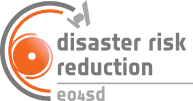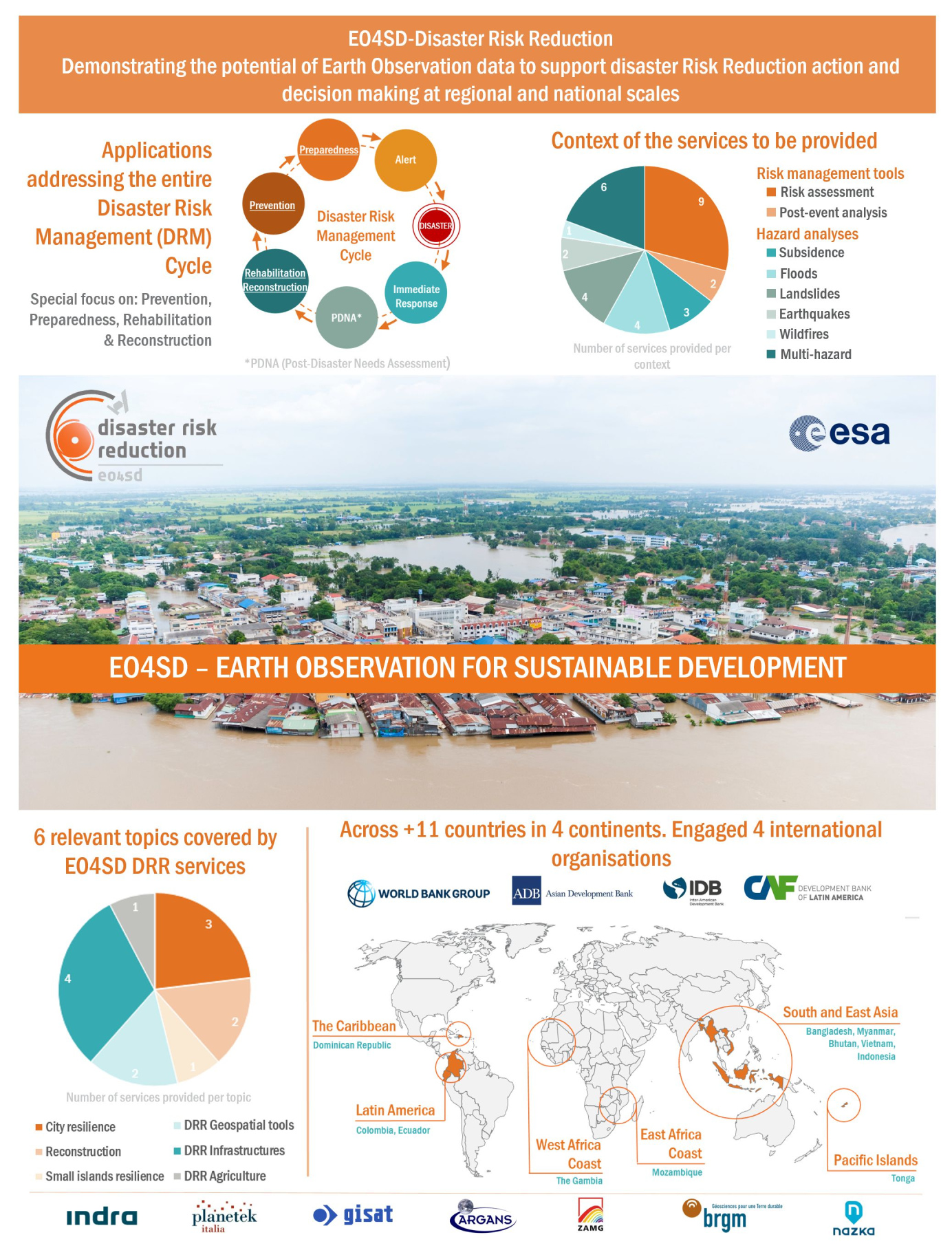The EO4SD-DRR consortium has completed Phase 1 with outstanding results, achieving strong engagement with stakeholders at different level in several IFIs, putting together a comprehensive portfolio and committing to provide demonstration exercises to twelve initiatives in more than fifteen countries.
Several levels of engagement were achieved from various International Financing Institutions (IFI). Different representatives of four international financing institutions were directly and personally informed about the benefits of Earth Observation for reducing the risk of disaster and the EO4SD program. The project was invited to a Brown Bag Lunch in Washington with the participation of Sameh Wahba (global lead of the practice of Disaster Risk Management) and Keiko Saito (regional leader of the same practice for Asia and the Pacific), an also engaged closely with Ana Campos and Niels Holm-Nielsen (leaders of DRM for Africa and global respectively) in several in person and virtual meetings. As for the Asian Development Bank (ADB), the directors of the Environment, Natural Resources and Agriculture Divisions of the 5 geographical divisions were visited in Manila by a consortium representation as well as the Climate Change and Disaster Risk Management Division main specialist. The office of the Inter-American Development Bank (IDB) in Europe, received a consortium delegation and helped promote the project in the headquarters chaired by its director Ignacio Corlazzoli. Finally, the CEO of the Development Bank of Latin America (CAF), Luis Carranza, and its Europe representative, Jose Antonio García Belaunde, received the EO4SD-DRR team and helped strengthen the cooperation.
During Phase 1 , the team also consolidated the stakeholder’s engagement in several meetings and workshops. Connections were made with the City Resilience Program’s (CRP) representatives in Madrid and with members of the Dominican Republic’s Public Administration. The EO4SD consortium was likewise invited to participate in events such as the Understanding Risk Forum in West and Central Africa 2019 in Abidjan (Cote d’Ivoire) in November and the UN Climate Change Conference COP 25 that took place in Madrid in December. Technical Team Leaders of the WB and IDB in Washington and ADB in Manila received the visit of the cluster and engaged at high level in two different occasions each that would later on facilitate long term activities between ESA and the WB.
During the stakeholder’s engagement process there was also a need to learn and assimilate the user’s need and adapt the service portfolio. After initial gathering and understanding of these, the technical team leaders have had several informal trainings. Interaction with more than 56 stakeholders/groups has been maintained over time with continuous communication and discussions about understanding needs, potential solutions and adapting some services of the end-to-end chain.
EO4SD-DRR has achieved impact globally, compromising demonstration exercises across more than eleven countries in four continents: South America and the Caribbean, West and East Africa, South and East Asia and the Pacific Islands. Three of the four IFIs engaged are in South America and the Caribbean: the WBG, present in Colombia and Dominican Republic; the IDB, also in Dominican Republic; and CAF, in Ecuador. The engagement in South and East Asia has been represented by the WBG in Myanmar, Laos and Buthan; as well as the ADB, also in Buthan and Indonesia. As for West and East Africa, the commitment of the WBG is seen in The Gambia and Mozambique. In the Pacific Islands, Tonga has received the support of the ADB.
The services produced are varied and the thematic areas covered by these depend on the context of the hazard in each area studied, composed of geo and hydrometeorological hazards. These were subdivided into ten specific services: terrain deformation analysis, landslide inventories, landslide susceptibility assessment, earthquake impact assessment, tsunami assessment, flood hazard mapping, flood susceptibility analysis, storm surge/coastal flooding analysis, drought monitoring and wildfire analysis. The hazard analyses are fundamental to be able to supply risk assessment, an important tool in the scope of the project, providing nine different services.
Six pertinent topics are covered by EO4SD-DRR services, such as city resilience, reconstruction, small islands resilience, DRR Geospatial tools, DRR infrastructures and DRR agriculture. For each service, several demonstrations were provided by the IFIs (WBG, ADB, IDB and CAF) around the globe. The initiatives took place in eleven countries, and various cities for the CRP, with their own particular aim.
The cluster will deliver demonstration exercises for the WB for city resilience in The Gambia, as well as for the CRP in several cities across the globe; as for DRR geospatial tools, the WB will have inputs in the Dominican Republic; DRR Infrastructure service will be provided in Bhutan, Colombia and Myanmar; and reconstruction will be covered in Mozambique. The ADB will have demo exercises in Indonesia with reconstruction; supporting small island resilience methods for Tonga; and covering DRR agriculture in Bhutan. As for the IDB, DRR infrastructure demonstration will be demonstrated in the Dominican Republic. Last but not least, the cluster will support city resilience in Ecuador.
This initiative has used space technology by providing monitoring services for the rehabilitation and reconstruction phases in Central Sulawesi (Indonesia) one year after its 2018 earthquake, in support to the Emergency Assistance for Rehabilitation and Reconstruction Project (EARR) and Enhance Water Security Investment Project (EWSIP). The engagement in Sulawesi has been a success, by providing the services necessary, capacity building as well as engagement and consolidation with the Asian Development Banks and Indonesian stakeholders.
In Phase 2, EO4SD-DRR is composed of seven international partners: Indra, Planetek, Gisat, ARGANS, ZAMG, BRGM and Nazka. Each partner has specific roles and responsibilities in the production and generation of the EO outcomes and services, as well as for the interpretation of the results. The components are verified by cluster rather than by partner, seeing as the cluster combines expertise in different fields and only together can guarantee the provision of the proposed EO-based information services.
To achieve its purposes, the EO4SD Disaster Risk Reduction initiative mainly focuses on providing applications and several services to its various clients. These applications address the entire Disaster Risk Management (DRM) cycle, consisting on its different phases. The stages in which EO4SD-DRR mainly puts its emphasis on are prevention, preparedness, rehabilitation and reconstruction, but also takes into consideration immediate response after the disaster, Post-Disaster Need (PDNA) assessment and being alert. These steps are all necessary to minimise and mitigate the risk that follow any natural or man-made hazard.


